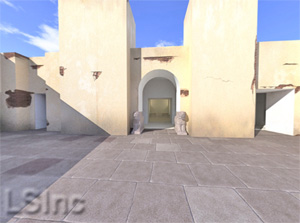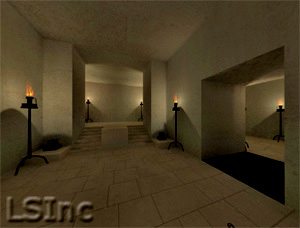Tell HalafSyria |
Tell HalafSyria |
page added December 21, 2007
|
|
| Excavations in the lower city at Til Barsib (below and to the northwest of the palace) have revealed some meager remains of an Assyrian-period temple and sculpture that plausibly could have come from that structure.
A contemporary temple was uncovered at Tell Halaf; it is nearly fully intact, but lacks sculpture and interior decoration (except for engaged, colored half-round columns set into the walls at the end of two rooms). The Assyrian temple from Arslan Tash does not survive very well; however, its guardian animals (bulls and lions) that once stood at the main entries were found in good condition and are now at the museum in Aleppo. All three sites lie relatively close to one another on known trade routes. The preserved pieces from the temples have been brought together to create a plausible Assyrian temple for the site of Til Barsib (in order to complete our educational package, providing students with a palace, a temple, and a city gate). |
|

Inner courtyard to the Halaf temple complex; the main sanctuary is through the archway, flanked by lions (based on examples from Arslan Tash). |

The main sanctuary, with the subsidiary space at the right (with the engaged half columns at its end wall). |
| All the walls of the Tell Halaf temple consist of mud bricks, 40 x 40cm square. Wall surfaces were smoothed with a coat of mud plaster, on top of which was a coat of white gypsum plaster. The pavement throughout consisted of smoothed, rectangular limestone slabs. | The sanctuary was divided into an eastern part, where cult activity presumably took place, and an elevated western part, 90cm higher, where the statue or symbol of the deity should have been located. The northwest and southwest corners of the lower part of the sanctuary each had a stairway of seven steps leading up to the platform. None of the superstructure of the walls in this room survives, so that we cannot tell if or how it was decorated. |
|
Oppenheim, M. 1950. Tell Halaf II. Die Bauwerk, Berlin: Walter de Gruyter.
[primary excavation report for the architecture from Tell Halaf; ]
|
| Reference
Information
page created: December 19, 2007 page added: December 21, 2007 you are here: Learning Sites Home page ==> Learning Sites Index page ==> Til Barsib, Syria, Homepage ==> Tell Halaf temple this page's URL is: http://www.learningsites.com/Barsib/Til-Barsib_home.html page author: Learning Sites, Inc. © 2002-2007 Learning Sites, Inc. |